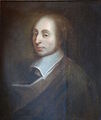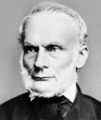Template:Selected anniversaries/August 24: Difference between revisions
No edit summary |
No edit summary |
||
| Line 8: | Line 8: | ||
||1561: Bartholomaeus Pitiscus born ... trigonometrist, astronomer and theologian who first coined the word trigonometry. Pic: book cover. | ||1561: Bartholomaeus Pitiscus born ... trigonometrist, astronomer and theologian who first coined the word trigonometry. Pic: book cover. | ||
||1595: Thomas Digges dies ... mathematician and astronomer. | ||1595: Thomas Digges dies ... mathematician and astronomer. He was the first to expound the Copernican system in English but discarded the notion of a fixed shell of immoveable stars to postulate infinitely many stars at varying distances. He was also first to postulate the "dark night sky paradox". Pic: https://www.pinterest.com/pin/466967055096765851/ | ||
File:Blaise Pascal.jpg|link=Blaise Pascal (nonfiction)|1654: [[Blaise Pascal (nonfiction)|Blaise Pascal]] writes to [[Pierre de Fermat (nonfiction)|Pierre de Fermat]], describing his solution to the Problem of the Points (a probability problem) and asking Fermat to critique it. | |||
||1771: Georg Friedrich von Reichenbach dies ... scientific instrument maker, was born at Durlach in Baden on 24 August 1771. Pics. | ||1771: Georg Friedrich von Reichenbach dies ... scientific instrument maker, was born at Durlach in Baden on 24 August 1771. Pics. | ||
| Line 15: | Line 17: | ||
||1803: Gregorio Fontana dies ... mathematician. He was chair of mathematics at the university of Pavia succeeding Roger Joseph Boscovich. He has been credited with the introduction of polar coordinates. | ||1803: Gregorio Fontana dies ... mathematician. He was chair of mathematics at the university of Pavia succeeding Roger Joseph Boscovich. He has been credited with the introduction of polar coordinates. | ||
||1816: Daniel Gooch born ... laid the first successful transatlantic cables. Sir Daniel Gooch was an English railway pioneer and inventor who was trained in George Stephenson & Edward Pease's works at Newcastle upon Tyne. He was locomotive superintendent of Great Western Railway for 27 years, where as Brunel's right-hand man, he designed the best broad-gauge engines and invented “the suspended link motion with the shifting radius link” (1843). Gooch also experimented with a dynamometer carriage. In 1864 he resigned to concentrate on developing telegraphic communication. Sir Daniel Gooch and his son Charles, were the engineers who laid the first Atlantic Cable from the steamship The Great Eastern. Daniel became member of Parliment. Pic. | |||
||1821: Ernest Amédée Barthélemy Mouchez born ... French naval officer who became director of the Paris Observatory and launched the ill-fated Carte du Ciel project in 1887. | ||1821: Ernest Amédée Barthélemy Mouchez born ... French naval officer who became director of the Paris Observatory and launched the ill-fated Carte du Ciel project in 1887. | ||
| Line 23: | Line 27: | ||
||1875: Henry Louis Rietz born ... mathematician, actuarial scientist, and statistician, who was a leader in the development of statistical theory. | ||1875: Henry Louis Rietz born ... mathematician, actuarial scientist, and statistician, who was a leader in the development of statistical theory. | ||
||1886: William Francis Gibbs born ... naval architect, one of the most renowned in his time, having designed over 6,000 ships from a fireboat, to freighters, ocean liners and warships. Early in his life, he began building self-taught skills by studying blueprints and existing vessels. In 1915, Gibbs and his brother Frederic H., joined the International Mercantile Marine Company, but had their own firm by 1922 which converted an ex-German liner into the American luxury liner SS Leviathan. The Gibbs firm oversaw the design of 74% of all naval vessels built during WW II, making Gibbs an outstanding contributor to the American war effort. Postwar, he realized his lifelong dream: the 1,000 foot superliner, the SS United States, the fastest ship to cross the Atlantic. Pic. | |||
File:Rudolf Clausius.jpg|link=Rudolf Clausius (nonfiction)|1888: [[Rudolf Clausius (nonfiction)|Rudolf Clausius]] dies. He was one of the central founders of the science of thermodynamics. | File:Rudolf Clausius.jpg|link=Rudolf Clausius (nonfiction)|1888: [[Rudolf Clausius (nonfiction)|Rudolf Clausius]] dies. He was one of the central founders of the science of thermodynamics. | ||
| Line 31: | Line 37: | ||
||1893: Haim Ernst Wertheimer born ... biochemist and academic. | ||1893: Haim Ernst Wertheimer born ... biochemist and academic. | ||
||1894: Rudolf Oskar Robert Williams Geiger born ... meteorologist who was one of the founders of microclimatology (the study of the climatic conditions within a few metres of the ground surface). His observations, made above grassy fields or areas of crops and below forest canopies, elucidated the complex and subtle interactions between vegetation and the heat, radiation, and water balances of the air and soil. Pic: https://www.geographixs.com/koumlppen-geiger.html | |||
File:Mark Twain by Abdullah Frères, 1867.jpg|link=Mark Twain (nonfiction)|1896: Author and crime-fighter [[Mark Twain (nonfiction)|Mark Twain]] publishes new collection of short stories based on [[Gnomon algorithm functions]]. | File:Mark Twain by Abdullah Frères, 1867.jpg|link=Mark Twain (nonfiction)|1896: Author and crime-fighter [[Mark Twain (nonfiction)|Mark Twain]] publishes new collection of short stories based on [[Gnomon algorithm functions]]. | ||
| Line 41: | Line 49: | ||
||1907: Peter Thullen born ... mathematician. | ||1907: Peter Thullen born ... mathematician. | ||
||1917: Ralph Eugene Lapp born ... nuclear physicist and author who began his career in high-energy physics research with Arthur H. Compton. Lapp then worked at Chicago on the Manhattan Project. With 69 others, he signed Leo Szilard’s 17 Jul 1945 petition to President Truman, the month before the attack on Hiroshima. They urged that Japan should have an opportunity to surrender before use of the atom bomb. (Nevertheless, the actual attack was by surprise.) After the war, he researched the results in Japan. Lapp lectured across the U.S. He wrote 22 books on nuclear safety, including the dangers of nuclear fallout in The Voyage of the Lucky Dragon (1958). A Post book reviewer in 1956 called him “a one-man atomic truth squad and nuclear lie detector.” Pic: https://www.todayinsci.com/8/8_24.htm | |||
||1918: Otis Ray McIntire born ... engineer. After graduating from the University of Kansas with a BSc degree in engineering in 1940, he went to work as a research engineer for The Dow Chemical Company. During World War II, when rubber was in short supply, McIntire's work focused on developing a rubber-like substance that could be used as a flexible insulator. In an experiment, in which he combined styrene with isobutylene, he created a unique material that was solid yet flexible due to the tiny bubbles formed by isobutylene within the styrene. McIntire had invented foam polystyrene, more commonly known by its brand name, Styrofoam Pic: https://www.geni.com/people/Otis-Mac-McIntire/335726453760006055 | |||
File:Howard Zinn 2009.jpg|link=Howard Zinn (nonfiction)|1922: Historian, playwright, and social activist [[Howard Zinn (nonfiction)|Howard Zinn]] born. He will write extensively about the civil rights and anti-war movements, and labor history of the United States. | File:Howard Zinn 2009.jpg|link=Howard Zinn (nonfiction)|1922: Historian, playwright, and social activist [[Howard Zinn (nonfiction)|Howard Zinn]] born. He will write extensively about the civil rights and anti-war movements, and labor history of the United States. | ||
Revision as of 16:58, 17 August 2018
1654: Blaise Pascal writes to Pierre de Fermat, describing his solution to the Problem of the Points (a probability problem) and asking Fermat to critique it.
1819: inventor, engineer, and chemist James Watt dies. He made major improvements to the steam engine.
1888: Rudolf Clausius dies. He was one of the central founders of the science of thermodynamics.
1889: Steganographic analysis of Judge Havelock With Glass reveals two terabytes of encrypted data.
1891: Thomas Edison patents the motion picture camera.
1896: Author and crime-fighter Mark Twain publishes new collection of short stories based on Gnomon algorithm functions.
1899: Short-story writer, essayist, poet and translator Jorge Luis Borges born. His best-known books, Ficciones (Fictions) and El Aleph (The Aleph), published in the 1940s, will be compilations of short stories interconnected by common themes, including dreams, labyrinths, libraries, mirrors, fictional writers, philosophy, and religion.
1922: Historian, playwright, and social activist Howard Zinn born. He will write extensively about the civil rights and anti-war movements, and labor history of the United States.
2017: Signed first edition of Dard Hunter, Glyph Warden sells for three million dollars.









